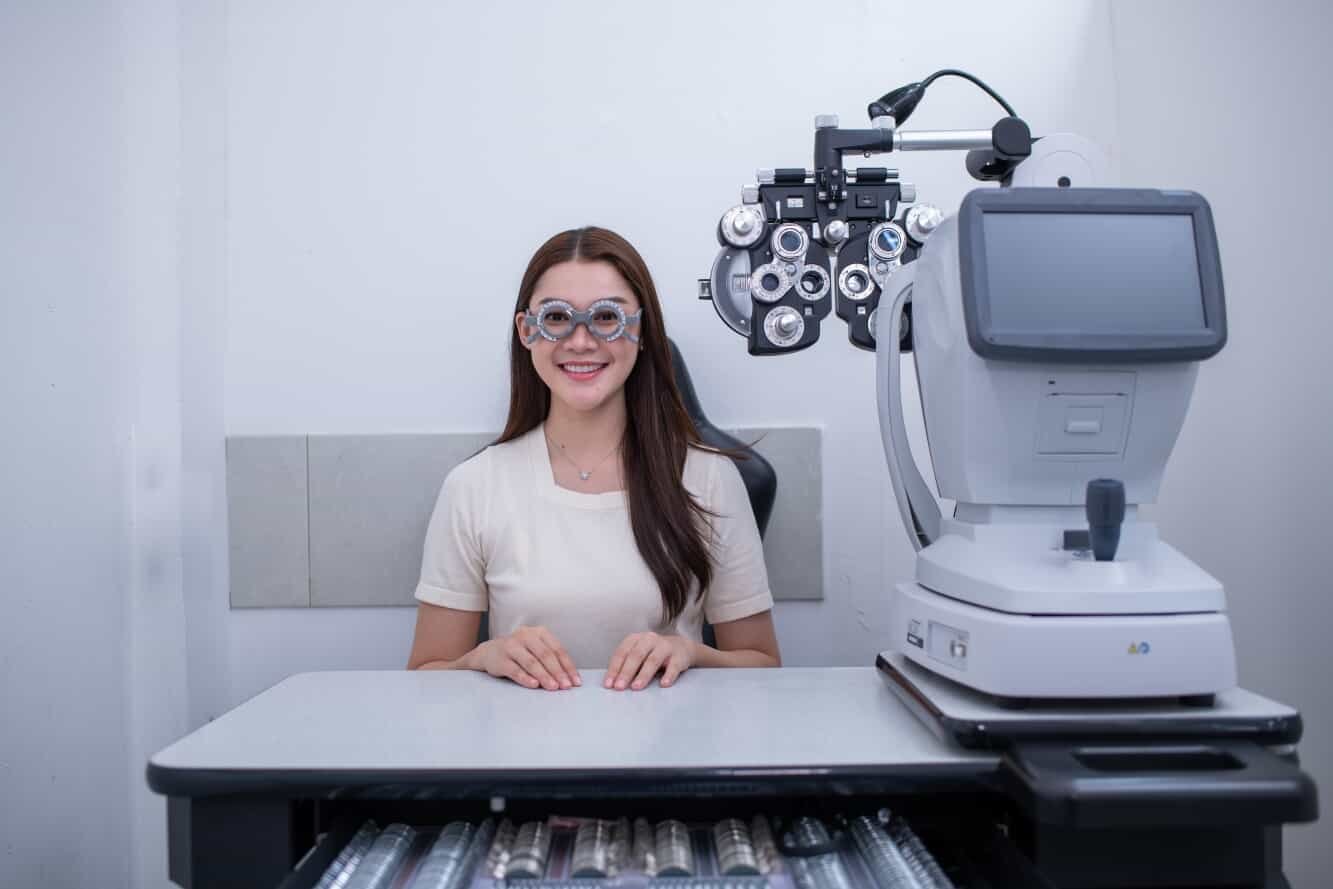No products in the cart.
Phoropter Machines Buying Guide: Comparing the Leading Models for Your Practice
Patients may not mention it, but they value the quality of their eye exam. When it’s accurate, they return and refer others. When it’s not, they don’t.
That’s why reliable equipment matters. The phoropter plays a central role in the exam’s speed and the accuracy of every prescription you write. If yours is causing slow refractions, inconsistent results, or unclear vision complaints, it may be time for an upgrade.
But this isn’t just about replacing old gear. Finding a phoropter that improves your workflow, sharpens accuracy, and builds patient trust is essential.
This guide is for you if you are looking for the best phoropter in 2025. It will help you find the latest options. Whether you run a solo practice, a growing clinic, or manage buying for an institution, this is true.
How to Choose the Right Phoropter: Key Decision Factors
Choosing the right phoropter isn’t just about picking the most high-tech model. It’s about finding the right fit for your practice style.
Below are the core factors to consider before investing in a phoropter.
Manual vs. Digital vs. Auto Phoropters
All phoropters do the same job, but they fit into your daily routine differently.
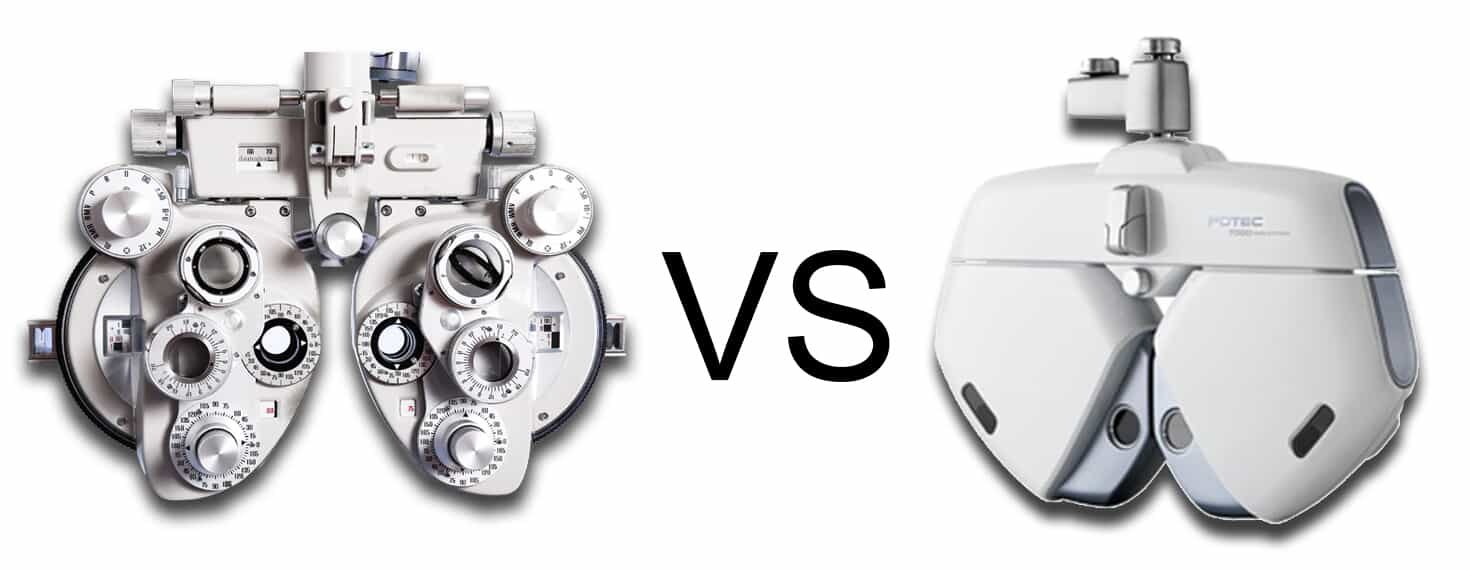
Manual phoropters give you direct control over every step of the refraction, from lens changes to cylinder axis adjustments, without relying on any software. However, they can slow things down, so they’re best for solo practices, students, or anyone who prefers a hands-on approach.
Digital phoropters are built for speed and integration. They shine when you want fast refractions, auto-lens switching, and clean EMR sync. The tradeoff? A higher price tag and some training time.
Auto phoropters do most of the work for you. They’re great for mobile clinics or fast-paced environments where efficiency matters more than customization. But they’re not ideal for complex prescriptions.
The bottom line? Choose based on how you work.
If you want full control, go manual. If you want to speed things up, go digital. If automation fits your setup, auto may be the way to go.
There, you can compare digital vs manual phoropters.
Accuracy and Speed of Refraction
Your phoropter’s accuracy directly affects prescription quality. Small misses can lead to unhappy patients. Speed also matters. A smooth, efficient exam improves the patient experience and keeps your schedule on track.
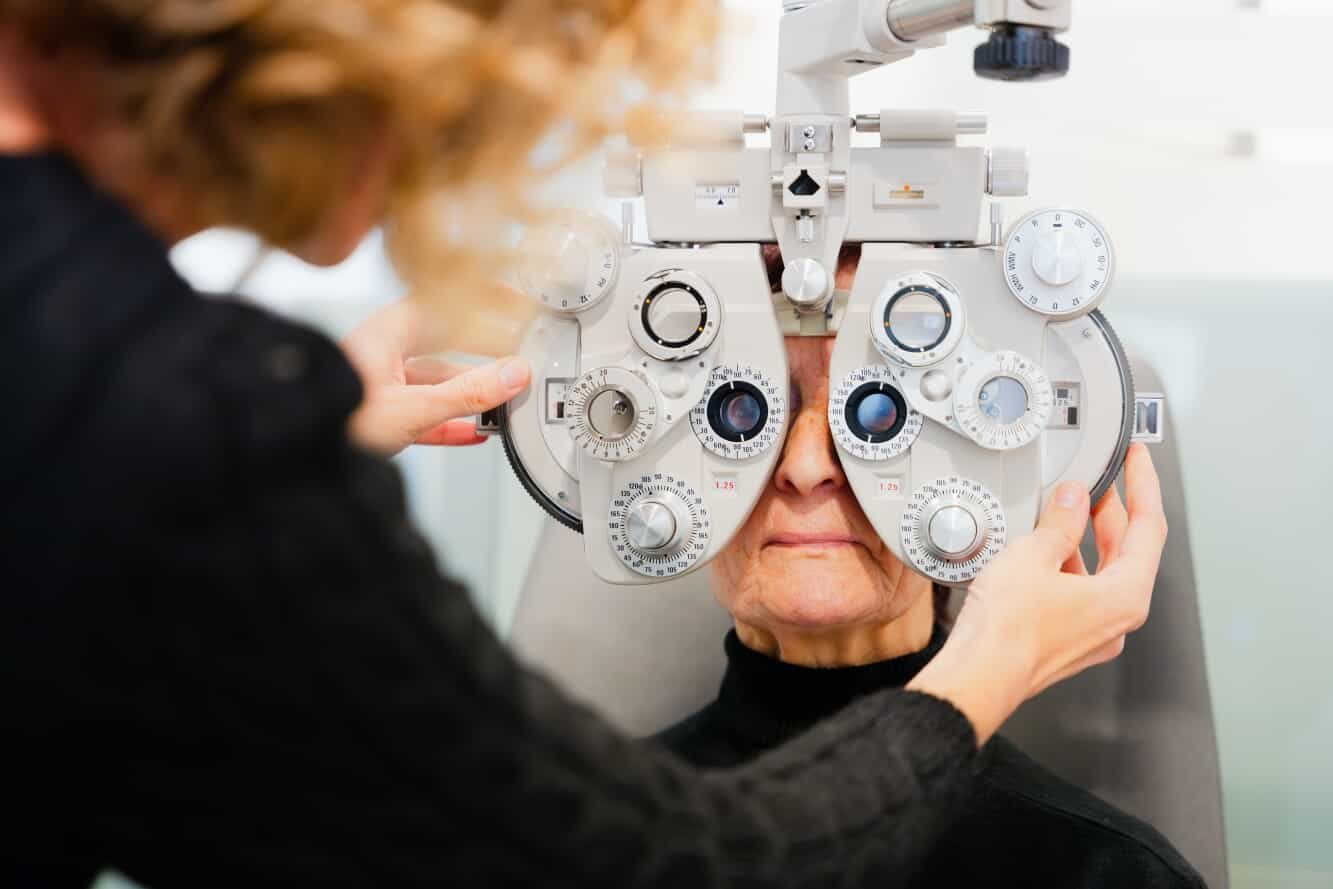
Digital and auto phoropters often speed things up, but speed doesn’t always mean accuracy. We’ve seen patients walk away with unclear vision even after using advanced phoropters.
That’s why it’s not just about being digital. Choosing a trusted brand with proven optics is important.
Read customer reviews. Ask colleagues. A fast exam only works if the result is spot-on.
Ergonomics for Patients and Practitioners
Comfort isn’t just for the patient. A well-designed phoropter reduces strain for both the operator and the patient.
Consider factors such as headrest stability, control layout, and the amount of repositioning you need during an exam. Smooth operation means fewer interruptions, better posture, and less daily fatigue.
EMR / EHR Integration Capabilities
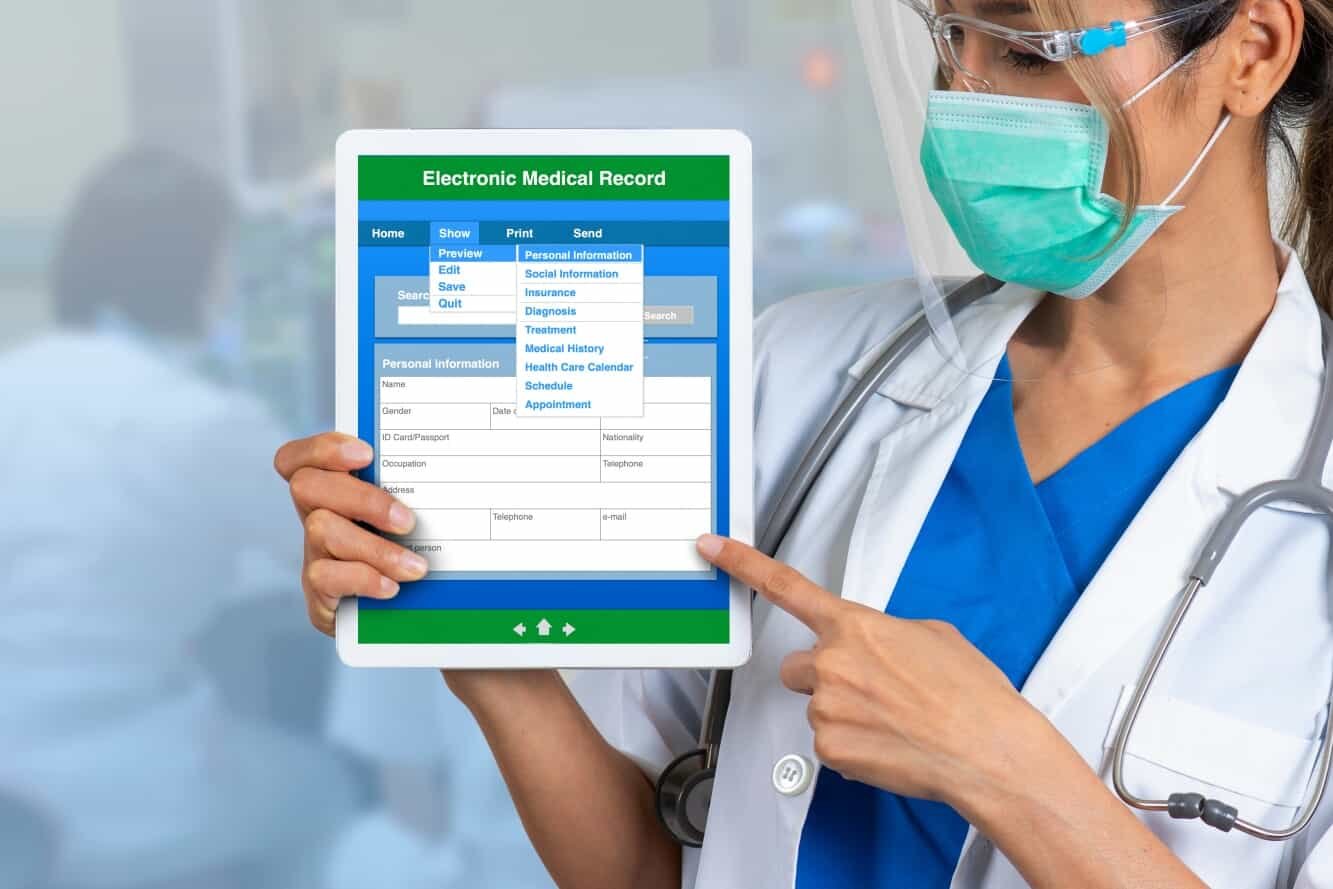
If your clinic uses electronic medical records, integration will speed things up. Many digital and auto phoropters can send refraction data directly to your EHR. This cuts out manual entry and reduces errors. Look for direct HL7 or DICOM integration if you’re aiming for seamless sync.
Customization and User Interface
The more intuitive the controls, the faster your team adapts. Look for models with programmable workflows, customizable settings, and easy-to-read displays.
Some systems allow you to set exam steps in advance. Others let you control everything manually. This is great for adjusting the exam to meet different patient needs.
Durability and Manufacturer Support
A phoropter is a long-term investment. Look into build quality, service history, and warranty coverage.
Is the manufacturer known for solid engineering and responsive support? Are replacement parts easy to source? These questions matter when you’re relying on the device day in and day out.
Total Cost of Ownership
Don’t just compare sticker prices. Consider ongoing costs like service contracts, parts availability, training time, and expected lifespan. Sometimes a more expensive model pays for itself in efficiency and fewer repairs. Think long-term.
Comparative Review of Top Phoropter Machines
In 2025, more practices will upgrade their exam lanes, making the phoropter market more competitive. New features, integrations, and automation options are available, but not every model fits every workflow.
Here, we look closely at five of the year’s most widely adopted phoropter systems.
This comparison will help you decide between popular models. We will examine the key differences between the Reichert SightChek and the Marco RT-700.
1. Reichert SightChek Digital Phoroptor ($4,500.00)
If your practice is ready to move from manual to digital, the SightChek is a solid option. The 10-inch tilting touchscreen makes it easy to run tests and adjust settings without adding clicks to your workflow. The central control knob keeps lens switching fast and familiar which is an important plus when working with patients prone to fatigue.
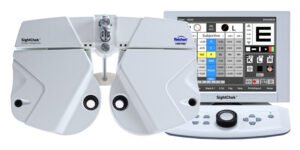
Built-in tests like Phoria, Fused Cross Cylinder, and Binocular Balance help standardize your process. Automatic near-vision tools save time during close-up testing. EMR integration works smoothly on the backend and cuts out manual data entry.
You won’t get complete automation here. However, if you want quicker exams and fewer mistakes in transcription, this is a great choice. You can still keep full control over your clinical work.
Key Features
- 10-inch tilting touchscreen interface
- Central control knob for fast lens switching
- Built-in guided tests (Phoria, Fused Cross Cylinder, Binocular Balance)
- Automatic convergence and illuminated near-vision testing
- Jackson Cross Cylinder and Split Cross Cylinder options
- 3 customizable refraction programs
- Seamless EMR integration and multi-device connectivity
Pros
- Streamlines workflow without losing manual control
- Near vision and astigmatism testing are well-supported
- EMR integration reduces errors and saves time
- Backed by Reichert’s reliable service
Cons
- A learning curve if your team is new to digital
- Higher upfront cost than basic digital models
Best For: Clinics moving from manual phoropters that want a faster workflow without giving up clinical flexibility.
2. Reichert Ultramatic RX Master Phoroptor ($3,900.00)
If you want full manual control, the Ultramatic RX Master Phoroptor offers a mechanical feel that many optometrists like. It offers precise rotary prisms, smooth, click-stop dials, and tight controls with no noticeable “play”. It is made from materials that resist corrosion. It also has a limited lifetime warranty, showing how long it will last.
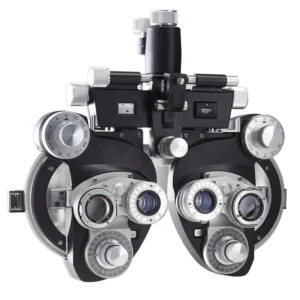
There’s no automation or EMR link here, and new staff may need extra time to get comfortable.
But if your practice values consistency, precision, and a tool that just works year after year, you may settle for this.
Key Features
- Precision rotary prisms for fine prism adjustments
- Smooth, solid-feel mechanical dials with no play
- Corrosion-resistant materials
- American-designed and engineered
- Plus or minus cylinder options
- Backed by a limited lifetime warranty
Pros
- Outstanding mechanical precision and feel
- Built to last long
- Instant, tactile feedback during refractions
Cons
- No digital features or EMR integration
- Takes time to train new staff on the manual workflow
Best For: Practices that want complete manual control and long-lasting mechanical reliability. This is especially true for ODs who value touch precision.
3. Marco RT-700 Illuminated Refractor ($1,700.00)
The Marco RT-700 is built for clinics where speed and efficiency matter, and operators still want the feel of a traditional refractor. Its adjustable light helps with measuring spheres, cylinders, and axes, making it easier to work in different lighting conditions.
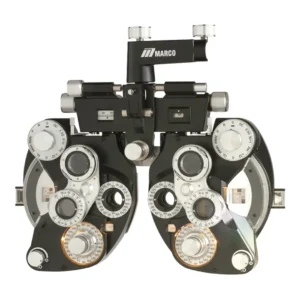
The fully synchronized axis and cross-cylinder system, along with smooth, knurled adjustment knobs, support precise refractions. The wing-grip design makes it easy to maneuver the refractor head during fast-paced exams.
The RT-700 performs best when integrated with the broader Marco system, which should be considered when budgeting for total setup costs.
Key Features
- Infinitely adjustable illumination for sphere, cylinder, and axis measurements
- White prism, accessory, and cross-cylinder scales for better visibility in dim light
- Fully synchronized axis / cross-cylinder system
- Smooth, knurled adjustment knobs
- Functional wing-grip design for easier refractor head control
- Certified Marco quality with a 5-year limited warranty
Pros
- Well-suited for high-throughput clinical environments
- Excellent ergonomics reduce operator fatigue during long exam days
- Quality build with long service life
Cons
- Performs best when used with other Marco equipment, which may increase total system cost
- Replacement parts and maintenance can be on the pricier side
Best For: High-volume practices already using, or planning to use, other Marco systems.
4. Visionix VX 65 Auto Phoropter ($4,700.00)
The Visionix VX 65 is built for clinics that want to save time on routine exams and reduce manual work. It is engineered for heavy daily use, with components tested to withstand 60,000 refractions over 10 years.
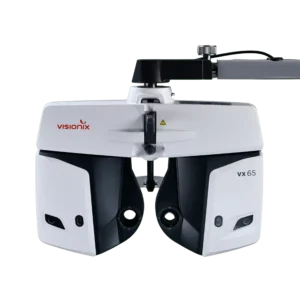
The system offers flexibility with auto, digital manual, and hybrid modes, making it easier for both experienced users and those new to digital phoropters. The tablet-based interface is simple to use, and you can add an optional control panel for quick access to key functions.
Data integration is solid, with wireless import and export to your EMR and other Visionix equipment. While it excels at handling routine cases quickly, it may not be ideal for more complex or non-standard prescriptions.
Key Features
- Three operating modes: auto, digital manual, hybrid
- Tablet interface with optional control panel
- Wireless data import and export with EMR and Visionix suite
- Up to six customizable refraction programs
- Fast, quiet lens transitions and startup
Pros
- Handles high daily exam volumes with minimal operator fatigue
- Flexible interface that supports both manual and automated workflows
- Strong EMR integration and wireless data handling
- Quick setup and easy for new users to learn
Cons
- Less effective for complex or highly customized prescriptions
- Works best if you already use other Visionix equipment, which can add to system costs
Best For: Clinics focused on speed and workflow efficiency, particularly in high-volume or space-limited environments.
5. Essilor Vision-R 800 Refraction System ($7,000.00)
The Vision-R 800 is a very advanced refraction system. It uses continuous power lens technology and is made for clinics that want to provide the most accurate prescriptions.

This allows sphere and cylinder values to change in 0.01 diopter steps. It provides final prescriptions that are accurate to 0.05 diopters. The result is a noticeably smoother and more natural refraction experience for the patient.
The system has Smart Programs and Smart Tests. These tools help the practitioner with the refraction process and make results consistent for different users. Features like camera-based vertex distance measurement, a wide field of view, and a fast, patient-friendly testing sequence contribute to a comfortable and efficient exam.
While the Vision-R 800 excels at precision and patient experience, its cost and sophistication may be more than smaller clinics require.
Key Features
- Continuous power variation with 0.01 diopter increments
- Final prescription accuracy to 0.05 diopters
- Smart Programs and Smart Tests for assisted standardized refraction
- Camera-based vertex distance measurement
- Thin profile for a wide field of view
- Quick test sequences to reduce patient fatigue
- Ability to compare prescriptions using real-world images
Pros
- Delivers highly precise and reliable prescriptions
- Provides a smooth and comfortable experience for patients
- Assisted programs make consistent results easier to achieve, even across multiple practitioners
- Efficient testing process saves time during busy clinic days
Cons
- One of the most expensive systems available
- Smaller or lower-volume clinics may not need this level of precision
Best For: High-end practices that want to stand out with accurate prescriptions and great patient care. It is also for clinics that want to ensure high-quality refraction for all users.
Comparison Chart: Side-by-Side Snapshot
This phoropter comparison 2025 snapshot examines five of the most widely adopted phoropter systems this year.
Model | Type | EMR Integration | Key Feature | Ideal For | Price on MenzoEye Clinic |
Reichert SightChek Digital Phoroptor | Digital / Hybrid | Yes | 10-inch touchscreen with guided test programs | Clinics upgrading from manual systems | $8,000.00 |
Reichert Ultramatic RX Master Phoroptor | Manual | No | Legendary mechanical precision and feel | Practices wanting full manual control and long-term durability | $3,900.00 |
Marco RT-700 Illuminated Refractor | Manual / Semi-digital | Limited (best with Marco suite) | Infinitely adjustable illumination and ergonomic controls | High-volume practices already using Marco systems | $1,700.00 |
Visionix VX 65 Auto Phoropter | Auto / Digital Manual | Yes | 3-in-1 mode with tablet or control panel | High-throughput clinics focused on workflow efficiency | $8,700.00 |
Essilor Vision-R 800 Refraction System | Fully Automated / Premium | Yes | Continuous power lens technology with 0.05 D accuracy | Premium practices prioritizing top-tier precision and experience | $7,000.00 |
Insights From Real Practices
Buying Considerations by Practice Type
Not every clinic has the same workflow, budget, or growth plan. What works well in a teaching hospital may be too much for a solo practice. A mobile clinic has different needs than a busy urban group.
If you are considering buying a phoropter for your optometry practice, some important factors should be considered. Knowing these things is good even if you are just starting your research.
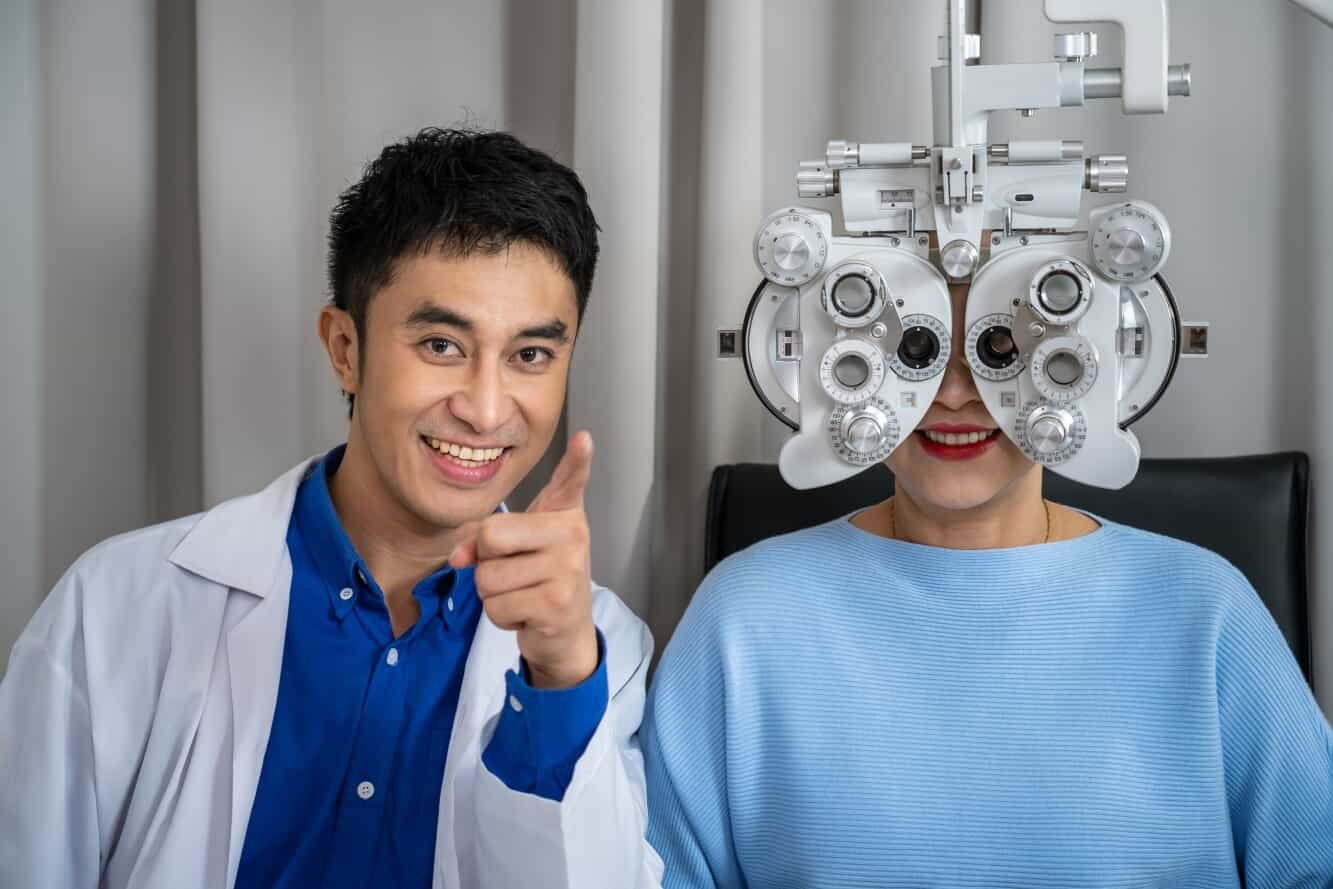
Solo Optometrists
Manual phoropters are often the smartest choice if you run a solo practice or a single-lane operation. They need no complicated setup, provide full control, and usually last longer. They also have lower maintenance costs.
Multi-Doctor Clinics
When multiple practitioners share exam lanes, consistency and workflow matter, digital systems like the Marco RT-700 or Essilor Vision-R 800 allow faster turnover, preset workflows, and seamless EMR sync.
Telehealth and Mobile Practices
Traditional phoropters are impractical for practices offering mobile exams or integrating with remote diagnostic models. Here, the Visionix VX 65 shines. Compact, remote-controlled, and fully automated, it is easy to transport and use in non-traditional settings.
Academic Institutions
In training environments, users with varying experience levels handle phoropters and use them frequently. Learning requires tough, consistent, and intuitive systems.
Optometry schools widely use manual models like the Ultramatic RX Master for teaching fundamentals.
Pitfalls to Avoid
Here are four common mistakes clinics regret and how to avoid them.

Buying Before Testing the UI with Your Team
A phoropter may look great in a demo video. However, the real test is whether your team can easily use it every day.
Interfaces that seem intuitive on paper can feel awkward in practice, especially under pressure. If possible, demo the system in-office or visit a colleague who is already using it. The more hands-on feedback you gather, the smoother the rollout will be.
Failing to Budget for Service Contracts
Many practices plan for the cost of the phoropter, but not for what happens when something breaks. Digital and automated systems require occasional calibration, software updates, and part replacements. Without a service agreement in place, repair costs can spike unexpectedly.
Always ask what the warranty covers, find out how long the service will take, and check if a support contract is worth the investment in your setup.
Ignoring EMR Compatibility
Integration can make or break your workflow. A phoropter that does not work well with your EMR system adds extra steps. This can lead to more data-entry errors and slow down documentation. Always confirm compatibility with your specific software; better yet, speak with other users who’ve implemented the same setup.
Choosing a Model Based on Specs Alone
Specs are helpful, but they don’t tell the whole story. A model may look good on paper, but if it is weak, poorly supported, or hard to teach, those details won’t matter. Focus on how the system performs in real clinics, not just in brochures. Durability, ease of use, and long-term workflow impact should weigh as heavily as feature lists.
Frequently Asked Questions
Is a digital phoropter significantly faster than a manual one?
Yes. Digital models automate lens changes and test sequences, saving 2–4 minutes per exam. Actual speed depends on staff familiarity and workflow setup.
What kind of maintenance do we require?
Manual phoropters need occasional cleaning and alignment and tend to last over a decade. Digital models require software updates and calibration and may need component replacements. A service plan is recommended.
Can these machines handle pediatric exams?
Yes, for children 6 and older who can follow instructions. Doctors usually prefer retinoscopy for younger children.
What’s the ROI on a $20K+ phoropter?
In high-volume settings, digital systems can pay for themselves in 12–18 months through faster exams, improved accuracy, and reduced documentation time.
Final Recommendations
If you have been using a phoropter buying guide for your next purchase, these tips will help you make the right choice.
Best overall value
Reichert SightChek Digital Phoroptor: A balanced choice for clinics moving to digital. Offers strong workflow improvements, guided testing, and EMR integration without sacrificing manual control.
Best for budget practices
Reichert Ultramatic RX Master Phoroptor: Proven mechanical precision at a lower cost. Minimal maintenance and built to last, ideal for clinics that value full manual control.
Best for tech-forward clinics
Essilor Vision-R 800 Refraction System: For practices focused on precision and innovation. Delivers ultra-accurate refractions with advanced automation and a standout patient experience.
Best patient comfort
Visionix VX 65 Auto Phoropter: Its smooth lens changes, fast test sequences, and flexible operation modes make it easy for patients, especially in busy or small spaces.
Ready to take the next step?
Schedule a demo to see any of these phoropters in action, or download our quick-buy checklist to compare models as you shop.
We’d love to hear from you. What phoropter are you using in your practice?
Got a favorite, a frustration, or a tip to share?
Drop us a line. Your feedback helps us keep this guide as useful and practical as possible.

